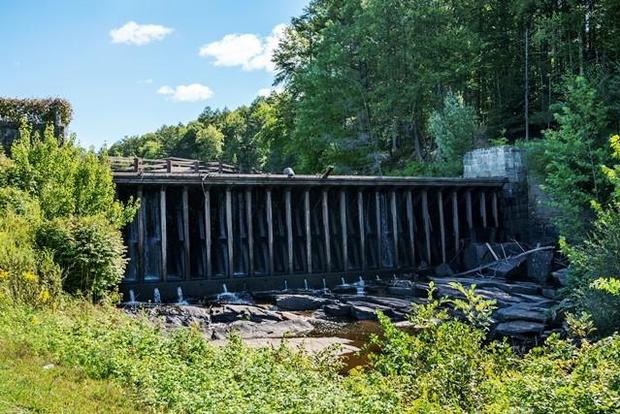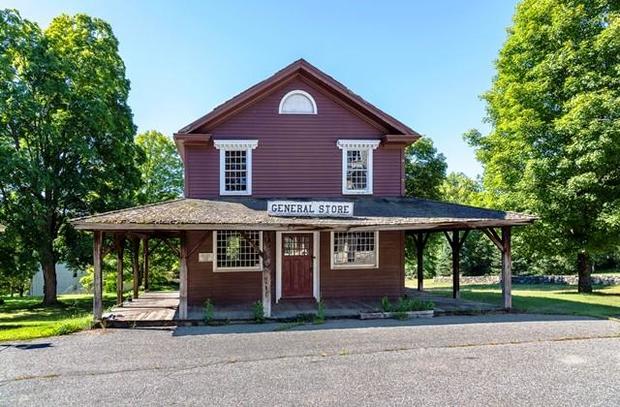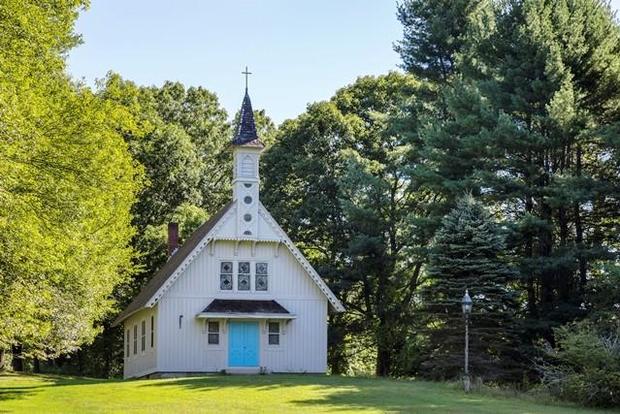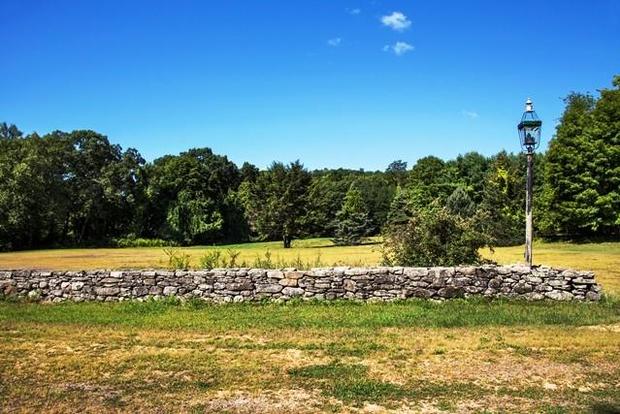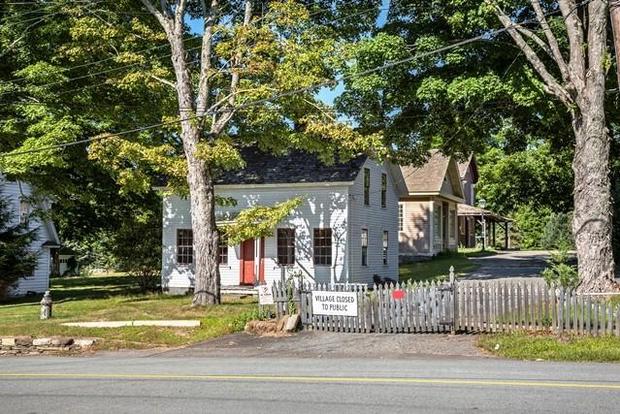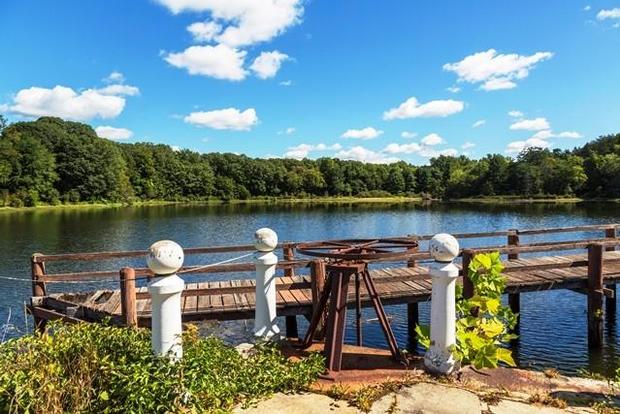Own the historic ghost town of Johnsonville
Photo courtesy of RM Bradley
Once again, the public has a chance to own Johnsonville, Connecticut.
The weird and desolate 19th century Victorian mill town is back on the market for $2.4 million after selling at auction for $1.9 million in October 2014, only to have the buyer's financing fall through, according to listing agent Jim Kelly of Figure Eight Properties and RM Bradley.
The 62-acre area in East Haddam has had many lives since it functioned as a hub of the twine industry in the 1830s, with hydro-powered mills taking advantage of its proximity to the Moodus River. Although it's no longer a twine hub, the local Neptune Twine and Cord Mill office still stands today. It was owned by three generations of the Johnson family that gave the town its name, according to Kelly, and was a supplier for the fishing industry and both World Wars.
Eventually, industrial progress took its toll: The once-bustling village of Johnsonville fell into disrepair and was deserted.
In the 1960s, the notoriously eccentric millionaire Ray Schmitt purchased the town with plans to restore it to its former glory. Schmitt, a retired aerospace equipment manufacturer, was an enthusiastic hoarder of Victorian curiosities and began adding bits of his collection (including small details like lamps and a paddleboat) to give Johnsonville a close-to-original appearance.
Schmitt was a collector of Victorian buildings as well as antiques. He bought and transplanted a 19th century Quaker meetinghouse; a Waterford, Connecticut, stable; and a general store to complement existing structures like the Johnson family homestead and the mill, according to Kelly.
"If you were from the East Coast, you knew what Schmitt's village was," Kelly said. "He created it through his travels."
Schmitt never intended to keep his efforts under wraps. From the start, his Johnsonville project was meant to be a tourist attraction, luring visitors to New England with its quaint milldam, grassy knolls and even a museum he had created in the Johnson family home marking the town's unique place in history.
Of course, that never quite took off.
Lightning struck the mill in the 1970s and burned it down. Schmitt later began fighting with officials from East Haddam about their claim that Johnsonville was causing "disruptions" during the unusually tourist-heavy holiday season, according to Kelly.
Mishap after mishap kept the carefully designed would-be tourist destination from reaching Schmitt's idea of its true potential. However, the village did have one notable and potentially redeeming moment in the spotlight: It appeared in Billy Joel's music video for the 1993 song "The River of Dreams (In the Middle of the Night)" before Schmitt passed away in 1998.
Once Johnsonville lost its ringleader, the town was sold to the Danbury, Connecticut-based Meyer Jabara Hotel Group, which has owned it since 2001 and had originally hoped to turn it into a residential community for adults over 55.
But in September 2001, the country and the economy took a dramatic turn. After September 11 and the subsequent financial unease, the company decided to wait on developing the area. Seven years later, the Great Recession hit, and the project was delayed again.
Johnsonville became a ghost town for the second time.
"The bottom line is they're hotel owners and operators first, and that's their expertise and their bailiwick," Kelly said of his client. "[Johnsonville] was an impulse buy that they thought they could get and do a destination development. But they shelved it because of two recessions and thought the best thing they could do was put it up for auction in the hands of someone who could develop it."
When the Auction.com auction in 2014 was ultimately unsuccessful, Meyer Jabara decided to relist the property in a more traditional way, hoping it would give potential buyers more time to view the property and get their finances in order, according to the Hartford Courant.
So far, the interested parties are kind of all over the board, running the gamut from individual investors to outdoor organizations and religiously affiliated summer camps.
"At this point, we have pretty consistent interest from six to eight different entities," Kelly said.
One group is another destination hotel company. Local vineyards are interested in cultivating Johnsonville's untouched land. A solar power company wants to take advantage of Johnsonville's bright upper 12 acres. And members of the film industry are interested in using it as a unique shooting location. There's even a group of people on Twitter, led by the Chicago-based writer/designer/programmer Dan Sinker, who have created a public Google Doc for people to discuss how to pool their money and buy the town.
When it comes to making a sale, one aspect of Johnsonville lore could either help or hurt its chances: Some people say the empty hamlet is haunted by Ray Schmitt's ghost, who has remained on the property he worked so hard to develop, unable to put it to rest.
According to Damned Connecticut, a regional blog about supernatural phenomena, Schmitt is the only ghost that's regularly mentioned. Its team didn't experience anything eerie on their visit to the town, except the unsettling feeling of being all alone.
Click ahead to see more of Johnsonville.
Own the historic ghost town of Johnsonville
Photo courtesy of RM Bradley
The general store was not native to the town, according to Kelly. However, it was built in 1858.
Own the historic ghost town of Johnsonville
Photo courtesy of RM Bradley
Johnsonville's Gilead Chapel was built in 1876. Schmitt brought it from Waterford, Connecticut.
Own the historic ghost town of Johnsonville
Photo courtesy of RM Bradley
This is the former Neptune Mill office, overlooking the Johnsonville millpond.
Own the historic ghost town of Johnsonville
Photo courtesy of RM Bradley
Here is another view of the former Neptune Mill office. It's one of Johnsonville's original structures, built by the Johnson family.
Own the historic ghost town of Johnsonville
Photo courtesy of RM Bradley
Johnsonville has lots of open space. But currently, there are no people to fill it.
Own the historic ghost town of Johnsonville
Photo courtesy of RM Bradley
This is the former Red House restaurant and banquet facility, built by Schmitt. It also used to be an antique shop where he sold vintage treasures.
Own the historic ghost town of Johnsonville
Photo courtesy of RM Bradley
A sign saying "village closed to the public." "No trespassing" signs are also strewn about the area.
Own the historic ghost town of Johnsonville
Photo courtesy of RM Bradley
Johnsonville's modest Centerbrook Meetinghouse, originally used by Quakers, was one of Schmitt's building transplants. It was built in 1843.
Own the historic ghost town of Johnsonville
Photo courtesy of RM Bradley
The 15-acre Johnsonville millpond has several bridges and docks around it.
